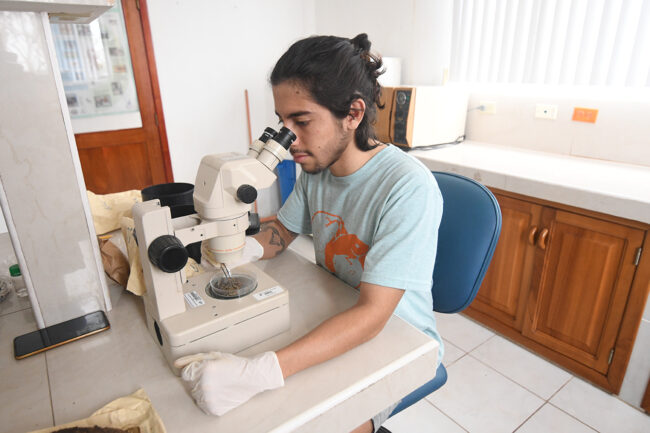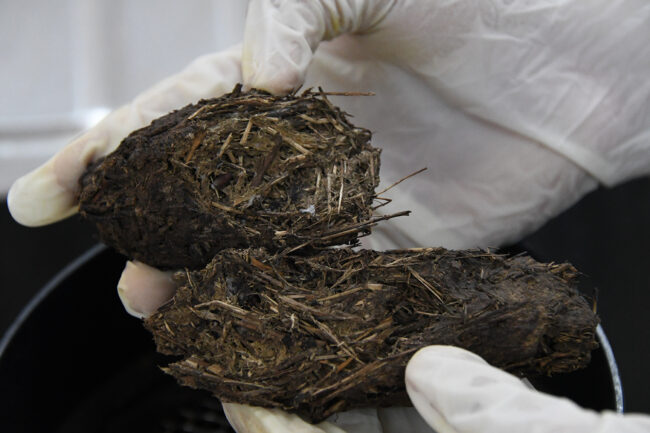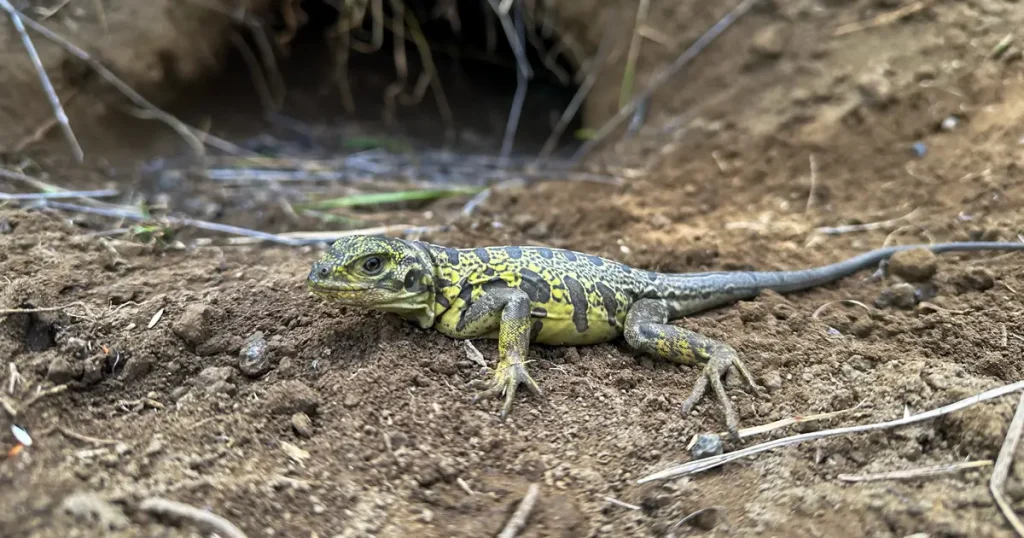Q&A: The Art of Studying Scat

Although fighting to save some of the world’s most iconic endangered species may sound glamorous, the true day-to-day can be anything but. Marco Antonio Jiménez Aguaisa is a thesis student working with Galápagos Conservancy’s Iniciativa Galápagos, helping us to learn more about the diets and movement of the Archipelago’s Giant Tortoises by studying their droppings.
Please tell us your name, what you are studying, and how you got involved with Galápagos Conservancy.
My name is Marco Antonio Jiménez Aguaisa and I come from a family of career park rangers including my father and uncles. I grew up surrounded by nature and my generation also became conservation-aware as environmental education programs became commonplace in and out of school. My first experience analyzing scat was in high school when I participated in a volunteer program with the Galápagos National Park Directorate (Park). Inspired by my family and Galápagos I decided to study biology at Santa Elena Peninsula State University on mainland Ecuador. Galápagos Conservancy is known for supporting local thesis students, and when I was looking for a thesis topic, it coincided with the need to do the tortoise scat analysis for Española Island. I joined the team under the supervision of Galápagos Conservancy scientists Wacho Tapia and Jorge Carrión in October 2021. I spend most of my time at the Park’s laboratory sorting and analyzing scat samples collected during field trips to Española.
Why study scat? What can animal droppings tell us about the animals who dropped them?
Scat analysis is a noninvasive research technique that helps determine the tortoises’ diet and distribution. The Galápagos Conservancy and Park team regularly collects tortoise scat during field trips to gain a better understanding of seasonal changes in tortoise diets. Examining which seeds are found in the scat can also indicate the potential for dispersal of invasive plants throughout the tortoises’ range. It is tedious work to separate and identify the thousands of seeds but what keeps me inspired is the discoveries to be made combing through material we normally find repugnant. To help identify the specific species, I separate the vegetal material contained in each sample into categories such as cactus, herbaceous, wood, flowers, and seeds. The post-ingestion analysis helps determine what they eat and, combined with the positional information on where the scat is found, also gives insights into their role as ecosystem engineers and the relationship with the plants in that habitat.

Where does this scat come from? How is it found?
My study is looking at scat from Española Island where we are particularly interested in the areas with cactus. As well as cactus being their preferred food, the tortoises are fundamental to spreading the seeds and the survival of the plantlings that sprout from the scat. The tortoises’ important role in the cactus life cycle was interrupted by their absence, leaving only adult cactus and no regeneration. The scat is collected from areas that the tortoises are known to frequent such as nesting areas and food and water sources. Prior to an expedition, the map of the island is divided into polygons that define the search area for each participant. This information is available in the field on the portable GPS that shows your exact location at any time and in any weather conditions. As each scat sample is collected it is individually labeled with a date and code that is linked to the location information housed in the GPS. Transporting the scat must always follow strict biosecurity protocols to protect the unique species found on each island.
What do you look for when sorting and studying scat? Is there good scat or bad scat?
All scat is good scat as within is a whole story to be revealed. The focus of this analysis of wild tortoise scat is to identify and classify the seed content. The number of and type of seeds indicate the tortoises’ food preferences, their distribution across the island, and the status of the cactus on Española; essential baseline data needed for planning this island’s restoration. However, I first look for the unusual in the obvious; a complete flower, a regular shape amongst the fibrous plant matter, an unnatural color and anything that is not vegetable matter. One of my recent finds was a Galápagos Land SnaiI inside the scat that was most likely swallowed along with the food. The scat also often contains insect pupa that may have been swallowed or deposited after. These insects potentially depend on the tortoises to provide this fertile base as part of their life cycle.

What do you hope to learn from studying tortoise scat?
The presence or absence of a principal herbivore can quickly change plant communities. If we know what plants the tortoises are eating and what seeds they are spreading, we get a glimpse into their daily life on the island. Plus, cactus recovery is linked to providing optimum conditions to support the growing population of tortoises. The ultimate goal is to obtain the baseline information that will guide management decisions about restoring vulnerable species so that natural processes can rewild the island and eventually all we need to do is monitor the progress.
Now, the question that we all want the answer to: Does tortoise scat smell bad?
Plant eaters don’t tend to produce smelly scat, and once it is dry there really is no smell. The scat is quite firm and well-formed into neat little bundles of partially digested plant material that look like a ball of the plants they swallowed. Leaves can come out almost as they went in as even though it can take several days to pass through the animal, there is not a lot of internal decomposition during the extraction of nutrients. Seeds pass through without damage.



